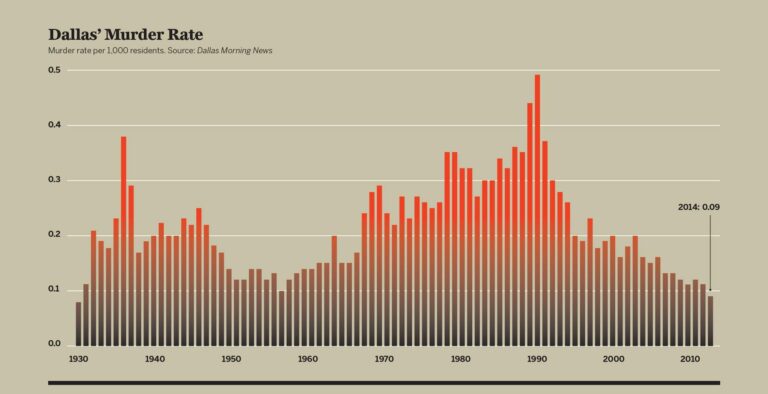Dallas Faces Escalating Violent Crime Amid Rising Homicide Numbers in July 2025
Sharp Increase in Dallas Homicides Sparks Public Safety Alarm
Dallas is currently confronting a troubling escalation in violent crime, with eight homicides recorded in just the first two weeks of July 2025. This surge has heightened anxiety among residents and officials, who worry that local law enforcement may struggle to keep pace if the trend continues. The spike highlights ongoing difficulties in ensuring community safety despite various intervention efforts.
Experts point to several key drivers behind this uptick in deadly violence:
- Escalating gang rivalries in specific districts
- Widespread availability of firearms fueling conflicts
- Economic inequality limiting youth prospects and increasing vulnerability
In response, police have intensified patrols in identified hotspots and launched new initiatives aimed at strengthening community relations and crime deterrence. The table below outlines the weekly homicide distribution for early July 2025:
| Week | Homicide Count |
|---|---|
| July 1ŌĆō7 | 3 |
| July 8ŌĆō14 | 5 |
Calls for Strengthened Policing and Holistic Violence Prevention from Community Leaders
In light of the recent violence surge, community advocates and city officials are pushing for a revamp of policing tactics. They stress the importance of boosting patrol presence in crime-prone neighborhoods and allocating additional resources to law enforcement to enhance responsiveness and deterrence. This coalition underscores that sustainable safety requires a united front involving police, social services, and local residents.
Beyond enforcement, leaders propose comprehensive violence prevention strategies targeting underlying issues, including:
- Expanded mentorship and engagement programs for at-risk youth
- Increased funding for mental health support and conflict mediation
- Formation of community task forces to proactively identify and mitigate threats
Transparency and accountability are emphasized as essential components to rebuild trust and foster long-term peace. The following table summarizes the prioritized action items and their anticipated benefits:
| Initiative | Projected Outcome |
|---|---|
| Enhanced Foot Patrols | Increased visibility and faster emergency response |
| Youth Mentorship Programs | Lower gang recruitment and improved life opportunities |
| Mental Health Services | Reduction in violence linked to psychological distress |
| Community Task Forces | Early detection and prevention of violent incidents |
Socioeconomic Challenges Fueling DallasŌĆÖs Violent Crime Surge
The rise in violent offenses, including the recent homicides, is deeply intertwined with socioeconomic hardships prevalent in many Dallas neighborhoods. Areas marked by elevated poverty, limited educational resources, and scarce employment opportunities tend to experience higher rates of violence. These conditions foster instability and heighten the risk of conflict.
Critical socioeconomic contributors to crime trends include:
- Unemployment rates surpassing citywide averages in multiple communities
- Educational disparities hindering youth development
- Housing instability causing frequent relocations and weakened community bonds
- Insufficient access to recreational and mental health services
The table below illustrates how these factors correlate with crime patterns:
| Socioeconomic Factor | Effect on Crime |
|---|---|
| High Poverty Levels | Elevates violent crime risk by eroding social support networks |
| Unemployment | Linked to increased gang activity among youth |
| Limited Educational Access | Associated with higher recidivism and delinquency rates |
| Housing Instability | Disrupts community cohesion, fostering crime-prone environments |
Strategic Focus on Mental Health and Youth Engagement to Mitigate Violence
Experts and community advocates alike emphasize that addressing violence requires investing in mental health resources and youth-focused programs. Without robust support systemsŌĆösuch as trauma-informed counseling and positive mentorshipŌĆöyoung individuals remain susceptible to influences that may lead to criminal behavior. Key recommended areas for investment include:
- Broadening mental health service availability in schools and vulnerable neighborhoods
- Creating safe, structured environments through youth outreach initiatives
- Training educators and community workers to recognize early warning signs of distress
- Fostering partnerships between law enforcement and social service providers
Recent data from a 2024 urban study reveals that cities enhancing funding for these programs experienced a 25% decline in violent crime rates over two years. The table below highlights the effectiveness of various interventions, offering a blueprint for Dallas policymakers:
| Program | Crime Reduction | Community Response |
|---|---|---|
| School-Based Counseling | 18% Decrease | Favorable |
| Youth Mentorship | 22% Decrease | Highly Positive |
| Safe Neighborhood Spaces | 20% Decrease | Positive |
| Trauma Awareness Training | 15% Decrease | Moderate |
Conclusion: Collaborative Efforts Essential to Combat DallasŌĆÖs Violent Crime Crisis
The recent surge in violent crime, marked by eight homicides in July 2025, highlights the pressing challenges Dallas faces in safeguarding its communities. City leaders, law enforcement, and residents are calling for integrated strategies that address both immediate security needs and the deeper social issues fueling violence. While ongoing initiatives aim to reverse this trend, the situation remains a stark reminder of the complex dynamics at play. Authorities encourage community members to share information and participate actively, reinforcing that collective action is vital to restoring peace and safety across Dallas neighborhoods.







